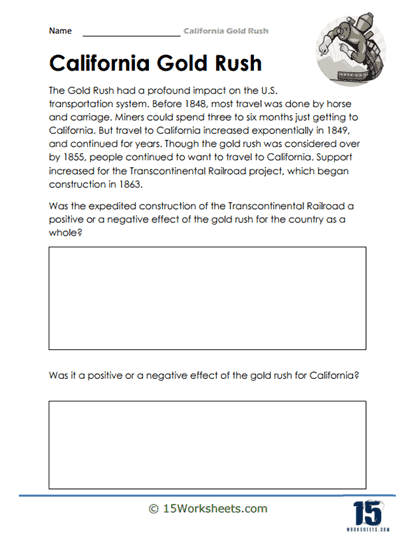Expediting Transportation Systems

Worksheet Description
The worksheet enters on the profound influence the Gold Rush had on America’s transportation system. It discusses how, prior to 1848, transportation was primarily reliant on horses and carriages, leading miners to spend several months reaching California. The surge of people flocking to California in 1849 and the following years was a significant factor in the country’s increased support for the Transcontinental Railroad project, which commenced its construction in 1863. The worksheet then poses questions about the broader implications of the Gold Rush on both the nation and the state of California, specifically inquiring about the railroad’s expedited construction.
To tackle this worksheet, students should begin by thoroughly reading and absorbing the information presented, ensuring they grasp the relationship between the Gold Rush and the subsequent changes in transportation. After understanding the context, students can reflect upon the provided questions. They should then articulate their thoughts, considering both the advantages and potential disadvantages brought about by the rapid development of the Transcontinental Railroad due to the Gold Rush. It’s essential that students provide reasoned arguments, drawing evidence from the text, and possibly external sources, to bolster their perspectives.
This worksheet aims to foster a deeper comprehension of the wide-ranging repercussions of significant historical events like the California Gold Rush. It encourages students to analyze the broader societal and infrastructural shifts catalyzed by such events, particularly emphasizing the Gold Rush’s role in shaping transportation advancements. Through the exercise, learners are prompted to consider the multifaceted effects—both positive and negative—of historical developments. Moreover, the worksheet cultivates critical thinking by urging students to evaluate the nuanced implications of the Gold Rush on the U.S. and California.
